Abstract
The mechanism of adsorption of the Streptococcus mutans enzymes responsible for the synthesis of insoluble dextran-levan to the S. mutans cell-wall binding sites has been studied. Certain characteristics of these binding sites are presented. The adsorption of these enzymes to the cell surface occurred rapidly without the addition of a source of energy and over a pH range of 3 to 11. The adsorption was inhibited by soluble dextran, probably due to the strong affinity of the polymer to the enzyme. All other polymers and sugars studied showed little or no inhibition. The adsorption was also inhibited by antibody globulin to the a-d immunologically specific group antigen surface polysaccharide of S. mutans and by anti-dextran globulin. The inhibition by anti-a-d globulin is considered to be due to a restriction of access of enzyme to the binding site of the enzyme which may be located in close proximity to the group antigen. On the other hand, anti-dextran globulin appeared to directly inhibit the adsorption by covering the binding site. Dextranase destroyed the binding site and released glucose from the S. mutans cells. These data indicate that S. mutans grown in media containing glucose possesses a small amount of dextran on the cell surface, and that this dextran is, or is a part of, the binding site for enzymes which synthesize the insoluble dextran-levan polymer. Trypsin inhibited the synthesis of insoluble polysaccharide and the adherence of cells. It is not clear in this case that destruction of the binding sites occurred. These data present a partial explanation of the processes which may be concerned in the formation of dental plaque on the smooth surfaces of teeth.
Full text
PDF

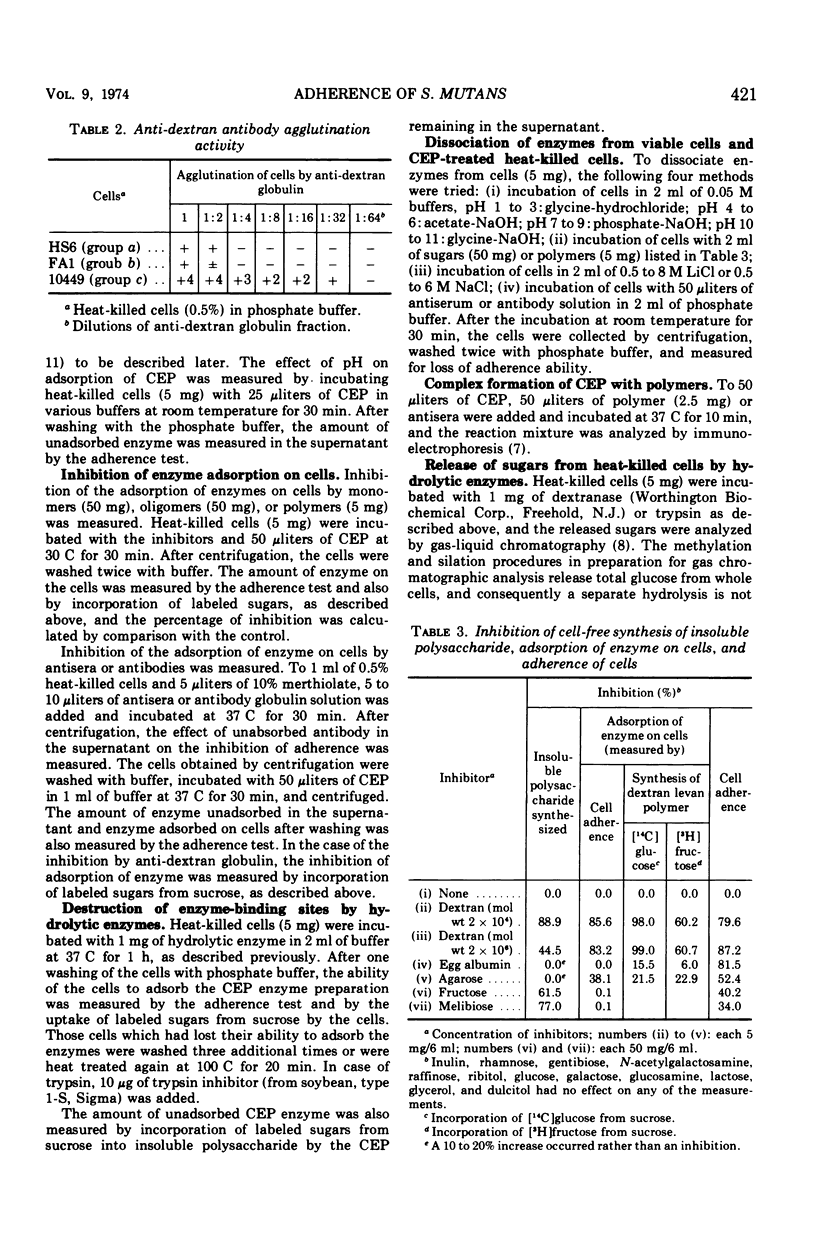
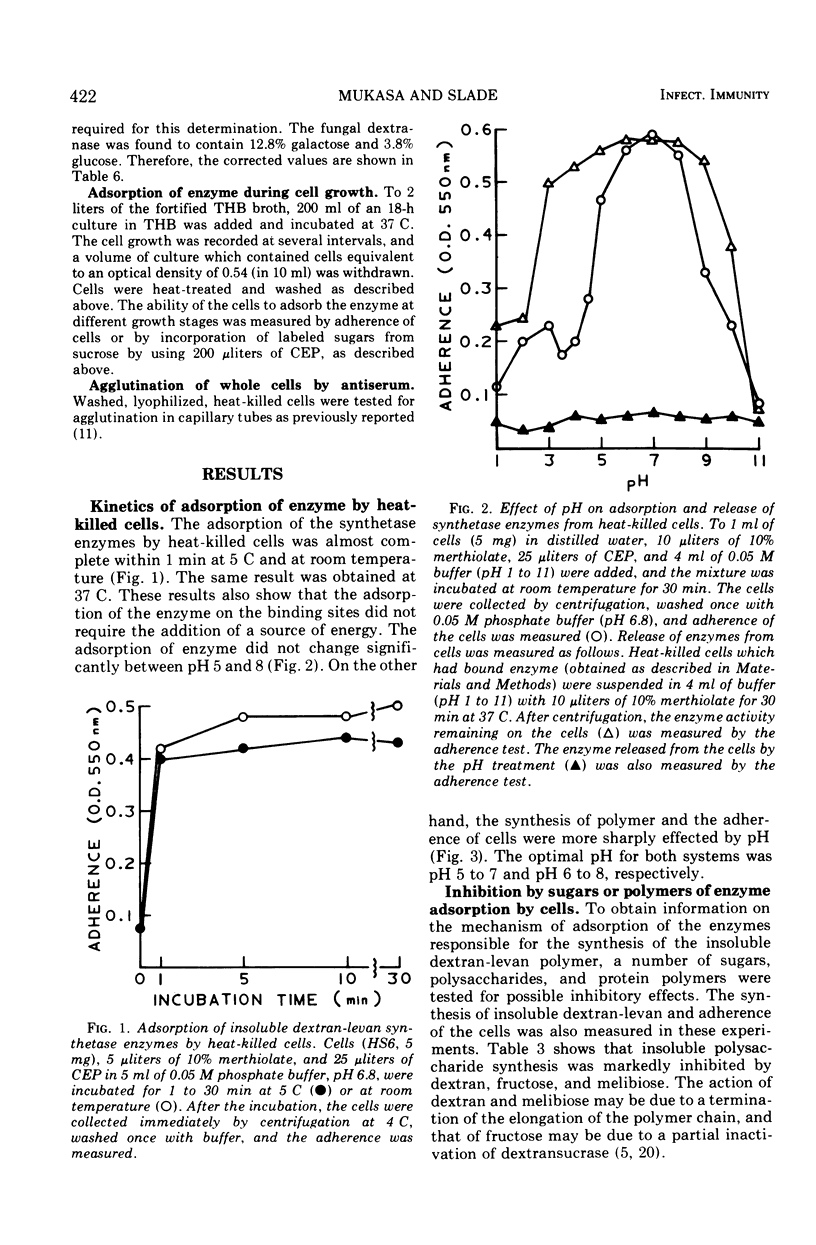

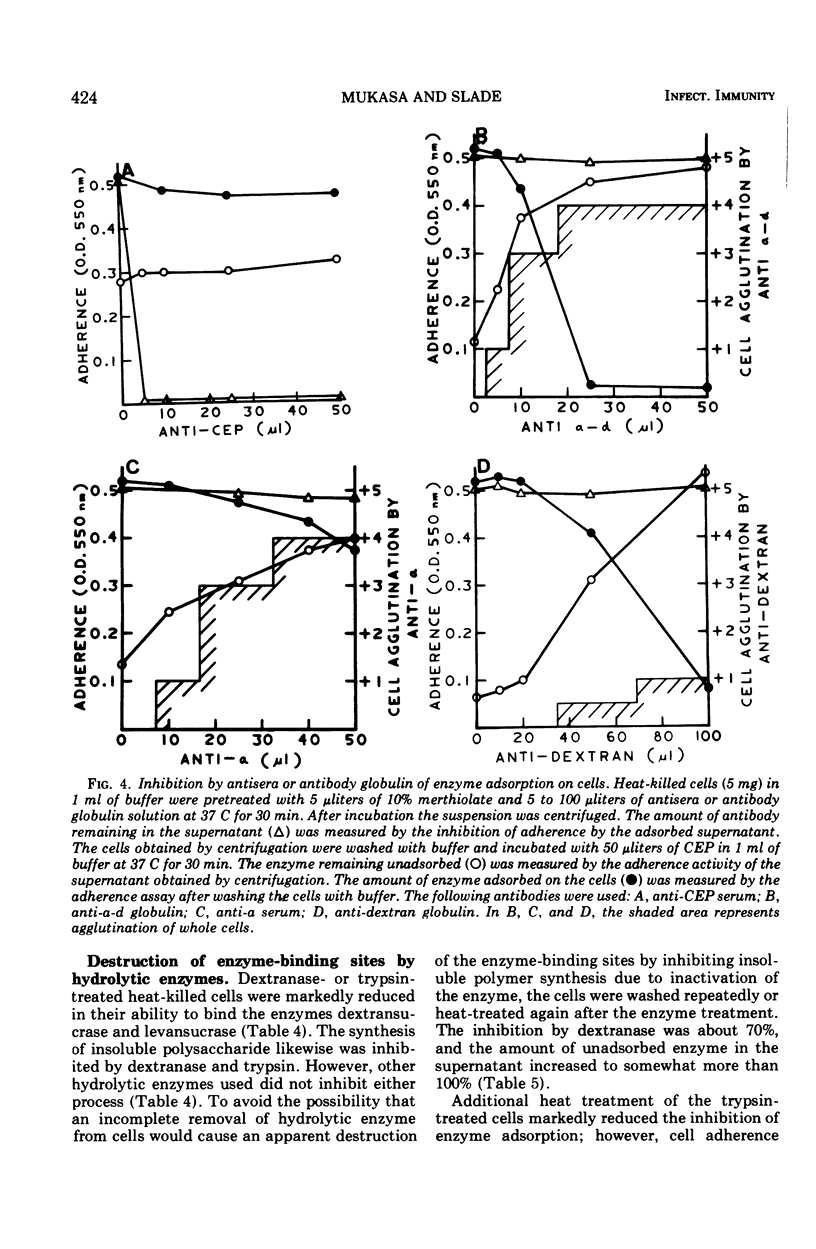

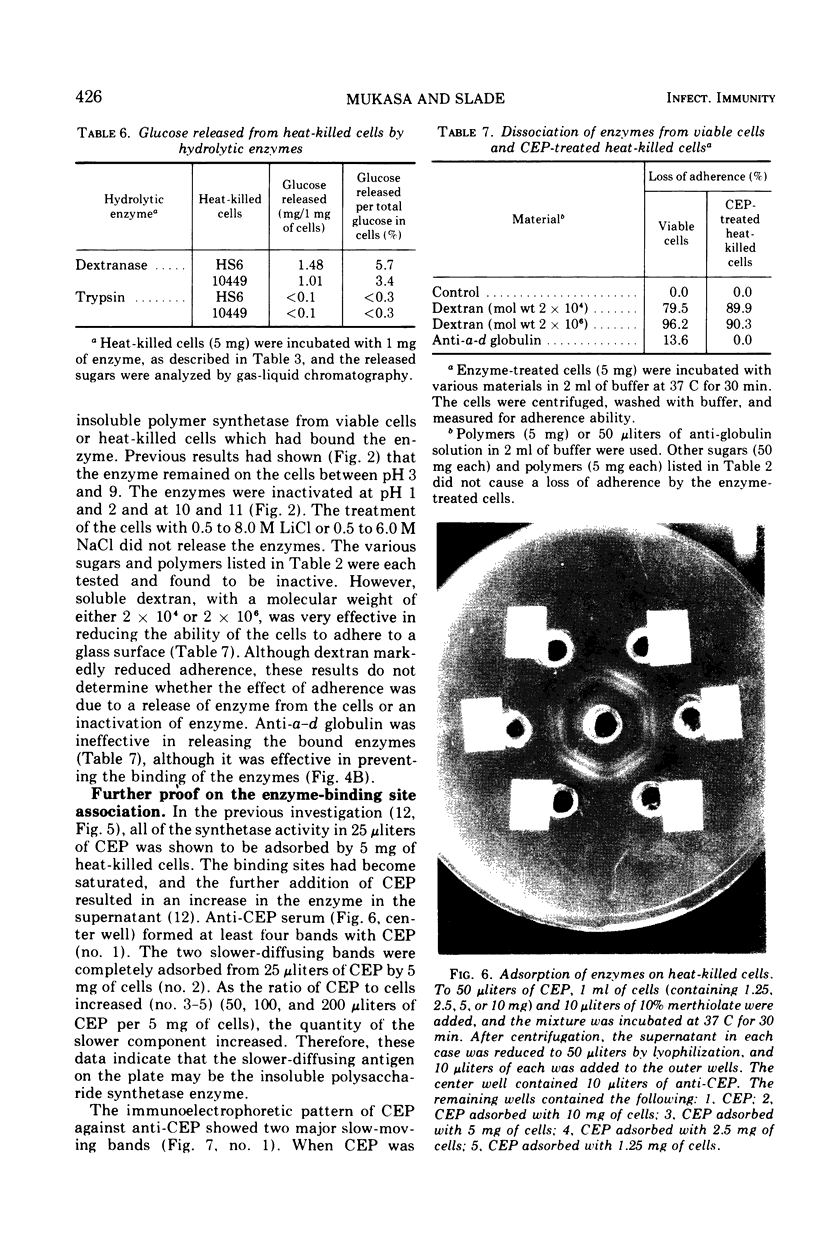


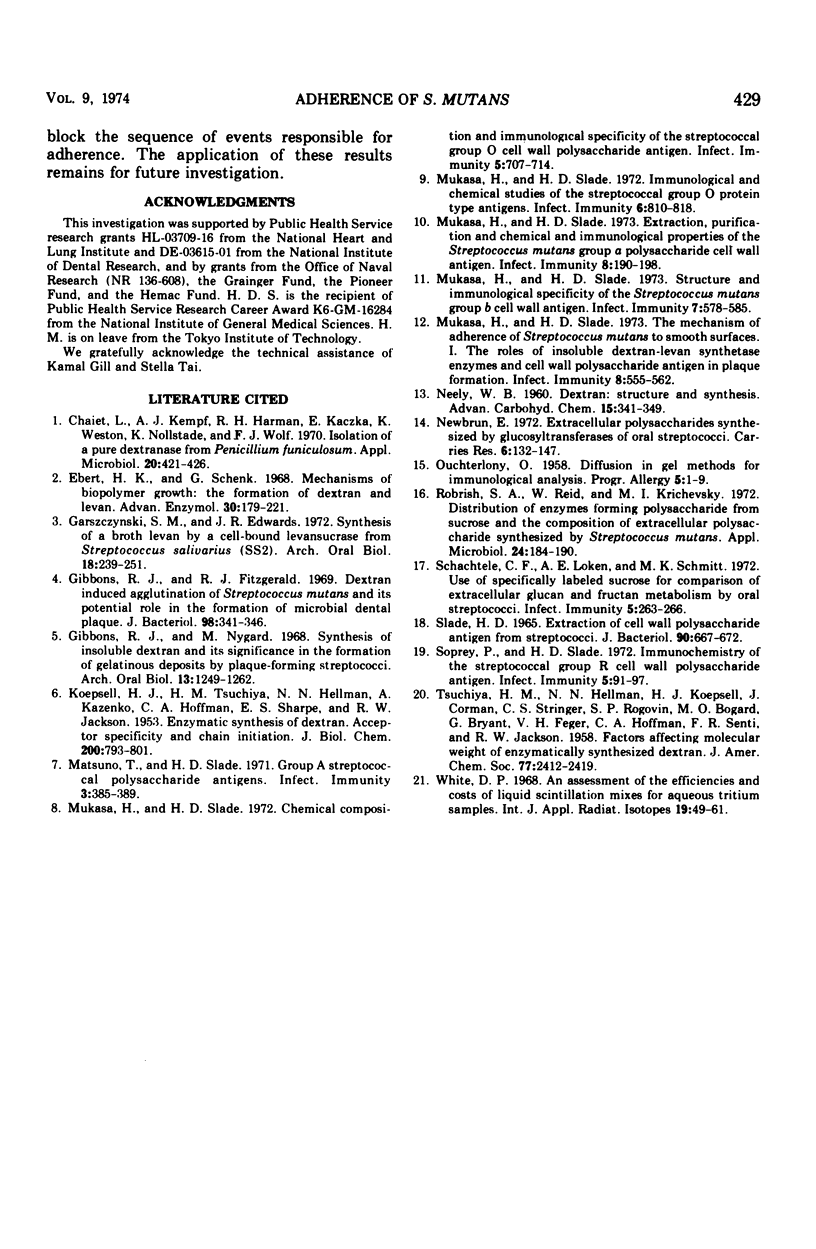
Images in this article
Selected References
These references are in PubMed. This may not be the complete list of references from this article.
- Chaiet L., Kempf A. J., Harman R., Kaczka E., Weston R., Nollstadt K., Wolf F. J. Isolation of a pure dextranase from Penicillium funiculosum. Appl Microbiol. 1970 Sep;20(3):421–426. doi: 10.1128/am.20.3.421-426.1970. [DOI] [PMC free article] [PubMed] [Google Scholar]
- Ebert K. H., Schenk G. Mechanisms of biopolymer growth: the formation of dextran and levan. Adv Enzymol Relat Areas Mol Biol. 1968;30:179–221. doi: 10.1002/9780470122754.ch4. [DOI] [PubMed] [Google Scholar]
- Garszczynski S. M., Edwards J. R. Synthesis of a broth levan by a cell-bound levansucrase from Streptococcus salivarius (SS2). Arch Oral Biol. 1973 Feb;18(2):239–251. doi: 10.1016/0003-9969(73)90144-1. [DOI] [PubMed] [Google Scholar]
- Gibbons R. J., Fitzgerald R. J. Dextran-induced agglutination of Streptococcus mutans, and its potential role in the formation of microbial dental plaques. J Bacteriol. 1969 May;98(2):341–346. doi: 10.1128/jb.98.2.341-346.1969. [DOI] [PMC free article] [PubMed] [Google Scholar]
- Gibbons R. J., Nygaard M. Synthesis of insoluble dextran and its significance in the formation of gelatinous deposits by plaque-forming streptococci. Arch Oral Biol. 1968 Oct;13(10):1249–1262. doi: 10.1016/0003-9969(68)90081-2. [DOI] [PubMed] [Google Scholar]
- KOEPSELL H. J., TSUCHIYA H. M., HELLMAN N. N., KAZENKO A., HOFFMAN C. A., SHARPE E. S., JACKSON R. W. Enzymatic synthesis of dextran; acceptor specificity and chain initiation. J Biol Chem. 1953 Feb;200(2):793–801. [PubMed] [Google Scholar]
- Matsuno T., Slade H. D. Group a streptococcal polysaccharide antigens. Infect Immun. 1971 Mar;3(3):385–389. doi: 10.1128/iai.3.3.385-389.1971. [DOI] [PMC free article] [PubMed] [Google Scholar]
- Mukasa H., Slade H. D. Chemical composition and immunological specificity of the streptococcal group O cell wall polysaccharide antigen. Infect Immun. 1972 May;5(5):707–714. doi: 10.1128/iai.5.5.707-714.1972. [DOI] [PMC free article] [PubMed] [Google Scholar]
- Mukasa H., Slade H. D. Extraction, purification, and chemical and immunological properties of the Streptococcus mutans group "a" polysaccharide cell wall antigen. Infect Immun. 1973 Aug;8(2):190–198. doi: 10.1128/iai.8.2.190-198.1973. [DOI] [PMC free article] [PubMed] [Google Scholar]
- Mukasa H., Slade H. D. Immunological and chemical studies of the streptococcal group O protein type antigens. Infect Immun. 1972 Nov;6(5):810–818. doi: 10.1128/iai.6.5.810-818.1972. [DOI] [PMC free article] [PubMed] [Google Scholar]
- Mukasa H., Slade H. D. Mechanism of adherence of Streptococcus mutans to smooth surfaces. I. Roles of insoluble dextran-levan synthetase enzymes and cell wall polysaccharide antigen in plaque formation. Infect Immun. 1973 Oct;8(4):555–562. doi: 10.1128/iai.8.4.555-562.1973. [DOI] [PMC free article] [PubMed] [Google Scholar]
- Mukasa H., Slade H. D. Structure and immunological specificity of the Streptococcus mutans group b cell wall antigen. Infect Immun. 1973 Apr;7(4):578–585. doi: 10.1128/iai.7.4.578-585.1973. [DOI] [PMC free article] [PubMed] [Google Scholar]
- NEELY W. B. Dextran: structure and synthesis. Adv Carbohydr Chem. 1960;15:341–369. doi: 10.1016/s0096-5332(08)60191-5. [DOI] [PubMed] [Google Scholar]
- Newbrun E. Extracellular polysaccharides synthesized by glucosyltransferases of oral streptococci. Composition and susceptibility to hydrolysis. Caries Res. 1972;6(2):132–147. doi: 10.1159/000259785. [DOI] [PubMed] [Google Scholar]
- OUCHTERLONY O. Diffusion-in-gel methods for immunological analysis. Prog Allergy. 1958;5:1–78. [PubMed] [Google Scholar]
- Robrish S. A., Reid W., Krichevsky M. I. Distribution of enzymes forming polysaccharide from sucrose and the composition of extracellular polysaccharide synthesized by Streptococcus mutans. Appl Microbiol. 1972 Aug;24(2):184–190. doi: 10.1128/am.24.2.184-190.1972. [DOI] [PMC free article] [PubMed] [Google Scholar]
- Schachtele C. F., Loken A. E., Schmitt M. K. Use of specifically labeled sucrose for comparison of extracellular glucan and fructan metabolism by oral streptococci. Infect Immun. 1972 Feb;5(2):263–266. doi: 10.1128/iai.5.2.263-266.1972. [DOI] [PMC free article] [PubMed] [Google Scholar]
- Slade H. D. Extraction of Cell-Wall Polysaccharide Antigen from Streptococci. J Bacteriol. 1965 Sep;90(3):667–672. doi: 10.1128/jb.90.3.667-672.1965. [DOI] [PMC free article] [PubMed] [Google Scholar]
- Soprey P., Slade H. D. Immunochemistry of the streptococcal group R cell wall polysaccharide antigen. Infect Immun. 1972 Jan;5(1):91–97. doi: 10.1128/iai.5.1.91-97.1972. [DOI] [PMC free article] [PubMed] [Google Scholar]




